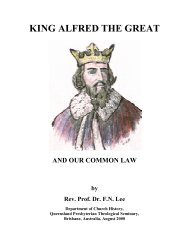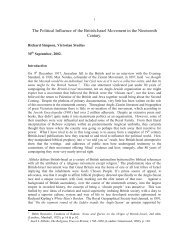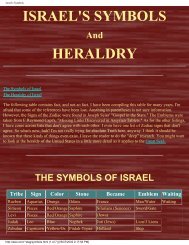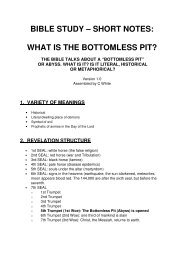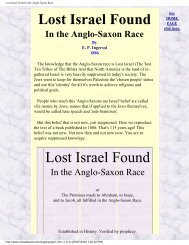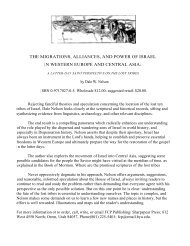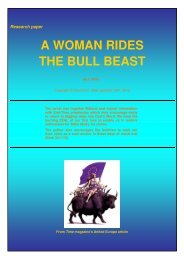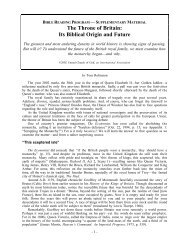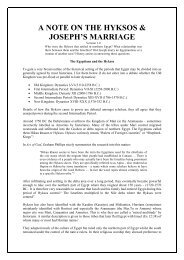CH. 6. COMMON LAW AMONG THE ANCIENT ... - Origin of Nations
CH. 6. COMMON LAW AMONG THE ANCIENT ... - Origin of Nations
CH. 6. COMMON LAW AMONG THE ANCIENT ... - Origin of Nations
Create successful ePaper yourself
Turn your PDF publications into a flip-book with our unique Google optimized e-Paper software.
The Celts were the foremost wave <strong>of</strong> that great Scythian tide which swept westwardacross Europe. There is not a product <strong>of</strong> the human mind in existence so extraordinaryas the Annals <strong>of</strong> Ireland. For in them, from a time dating more than two thousand yearsbefore the birth <strong>of</strong> Christ, the stream <strong>of</strong> Irish history flows down uninterruptedly.The Early Proto-Celtic migrants in IrelandO'Rahilly -- in his book The Goidels and Their Predecessors, and again in his great workEarly Irish History and Mythology -- distinguishes four successive later immigrations.First, that <strong>of</strong> the Cruithin -- some time before 500 B.C. Second, that <strong>of</strong> the Eraiin (aliasthe Fir Bolg) -- perhaps in the fifth century B.C. Third, that <strong>of</strong> the Laigin (together withDomnainn and Galioin) -- in the third century B.C. Finally came the Goidel -- around100 B.C.The notion <strong>of</strong> a series <strong>of</strong> invasions into Ireland is both historical and traditional. Theoldest extant record there<strong>of</strong>, is that written down by the Welsh historian Nenni (in 825A.D.). He clearly knew <strong>of</strong> three -- those <strong>of</strong> Partholan, Nemed and the Children <strong>of</strong> Mil.The latter, the Mil-esians or Goidels, came from Spain -- as also the Book <strong>of</strong> Invasionsdeclares.The second-millennium differentiation <strong>of</strong> the Proto-Celtic language into Goidelic (aliasC-Celtic cf. Irish-Scottish-Manx) and Brythonic (alias P-Celtic cf. Welsh-Cornish-Breton), originally took place after the settlement <strong>of</strong> the British Isles at some periodbetween circa B.C. 2000 and B.C. 600. C-Celtic is sometimes also called Q-Celtic, onaccount <strong>of</strong> the similar pronunciation <strong>of</strong> those two consonants. Details <strong>of</strong> this feature willbe given later.The Nemedians' descendants, the Fir Bolg, were defeated around B.C. 1900 by the seafaringFomor -- who came perhaps from Africa or Egypt. These Fomor in their turnwere overwhelmed by the 'supernaturally' powerful Tuathan de Danaan -- perhaps theIsraelitic Danites (Judges 5:17 & 13:2f & 18:1f?). They, in turn, were later in turnovercome by the Celtiberian Milesians from Spain.#21#The allegedly Pre-Celtic or rather Proto-Celtic inhabitants <strong>of</strong> Ireland alias Hibernia, seemto have been either Gael-s or Basqu-es from near Gal-icia on the Bay <strong>of</strong> Bisc-ay intoday’s Northwestern Spain alias Iberia. The 1974 Encyclopaedia Britannicaexplains#22# that the O-type blood group is particularly frequent among the Basques, theIrish, the Scots, and the Icelandic peoples. Moreover: Continental Celtic or Gaul-ishlanguages were once spoken widely in France; in Gal-icia on the Iberian Peninsula;throughout Central Europe; and in Gal-atia (in Asia Minor alias what is now Turkey).The family-community system in which the property belongs to the family and in whichthe family-head chooses his successors, is very common in Ireland and to the wholePyrenean region. The Basques -- blonder than their neighbours -- also show some5




